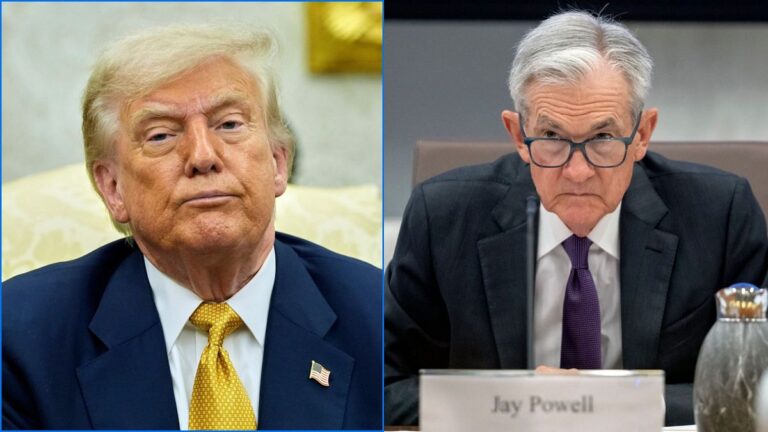ADVERTISEMENT
US stocks dipped temporarily on Wednesday following rumours that the US President is preparing to fire the Chair of the Federal Reserve, Jerome Powell.
But later, President Donald Trump said that he was “highly unlikely” to fire Powell. He made the public statement less than 24 hours after suggesting in a private meeting that he was leaning in favour of dismissing the head of the nation’s central bank.
Trump confirmed in a White House meeting Tuesday night with about a dozen House Republicans, that he had discussed the “concept” of dismissing Powell, because of his refusal to lower interest rates, as Trump wants.
“Almost every one of them said I should,” Trump said about the lawmakers who had come to talk to him about crypto legislation. He indicated he was leaning in that direction, according to a White House official.
During that session, Trump waved a letter about firing Powell, but a person familiar with the matter said it was essentially a prop drafted by someone else and that the Republican president has not drafted such a letter.
When asked directly if he was planning to fire Powell, Trump said, “I don’t rule out anything, but I think it’s highly unlikely.” That helped calm the market, and stocks erased their losses, though Trump added that he could still fire Powell if “he has to leave for fraud.”
Trump has been criticising a $2.5 billion (€2.16bn) renovation project of the Fed’s headquarters.
Why does Trump want to fire the Fed Chair?
The Federal Reserve has two main jobs: keeping the job market strong while keeping inflation under control.
Trump is unhappy that the Fed has not cut interest rates this year, a move that would have made it easier for US households and businesses to get loans to buy houses, build factories and otherwise boost the economy. Lower interest rates could also help the US government, which is set to borrow and add a lot more to its debt after approving a wide range of tax cuts.
But lowering interest rates would also give inflation more fuel when tariffs may be set to push prices for US households higher. That is why Powell has insisted he wants to wait for more data on how Trump’s stiff proposed tariffs will affect the economy and inflation before the Fed makes its next move.
Removing Fed Chair Jerome Powell might help Wall Street get the lower interest rates that investors love, but it would also risk a weakened Fed unable to make the unpopular moves needed to keep inflation under control.
A report on Wednesday said inflation at the wholesale level slowed to 2.3% last month, which was better than economists expected. It’s an encouraging signal, but it came a day after another report suggested that Trump’s tariffs are pushing up the prices US shoppers are paying for toys, apparel and other imported products.
Republican senators caution Trump against firing Fed Chair Jerome Powell
Federal Reserve Chair Jerome Powell is gaining some key backing on Capitol Hill from Republican (GOP) senators, some of whom began to speak up and warn that such a move would be a mistake. Trump would potentially obliterate the Fed’s independence from political influence and inject uncertainty into the foundations of the US economy if he fires Powell.
“If anybody thinks it would be a good idea for the Fed to become another agency in the government subject to the president, they’re making a huge mistake,” GOP North Carolina Sen. Thom Tillis said in a floor speech.
The measure of support from GOP members of the Senate Committee on Banking, Housing, and Urban Affairs showed how traditional Republicans are carefully navigating a presidency in which Trump often flirts with ideas — like steep tariffs or firing the Fed Chair — that threaten to undermine confidence in the US economy.
Tillis, who recently decided not to seek re-election after clashing with Trump, later told The Associated Press that the economic fallout from Powell’s firing would mostly hurt “little guys like me that grew up in trailer parks that may have a few thousand dollars in a 401k.”
He also pointed out that the underlying complaint that Trump has with the Fed — its reluctance to cut interest rates — is not controlled by Powell alone, but instead a 12-member committee.
“The markets expect an independent, central bank,” said GOP South Dakota Sen. Mike Rounds, who cautioned against firing Powell.
“And if they thought for a minute that he wasn’t independent, it would cast a spell over the forecasts and the integrity of the decisions being made by the bank.”
Still, plenty of other Republicans think that dismissing Powell is a fine idea.
“The most incompetent, worst Federal Reserve chairman in American history should resign,” said GOP Ohio Sen. Bernie Moreno.
Do presidents have the authority to fire the Fed Chair?
House Speaker Mike Johnson, R-La., told reporters that he was “unhappy with the leadership” at the Fed, but added, “I’m honestly not sure whether that executive authority exists” to fire Powell.
House Financial Services Committee chair French Hill has underscored that presidents don’t have the authority to fire the Fed Chair, yet has also been sympathetic to Trump’s complaints about Powell’s leadership. He and other Republicans have also noted that Powell’s term as chair is ending next year anyway, and Trump will have an opportunity to name a new Chair then.
Even those Republicans who argued that the president has grounds to fire Powell, and piled criticism on the central banker, conceded that it would still be a painful step.
“That’s a decision the president will make, and he’s being very deliberate about it,” said Moreno, the Ohio senator who called for Powell’s resignation. “But I don’t think we should put the country through any of that.”


